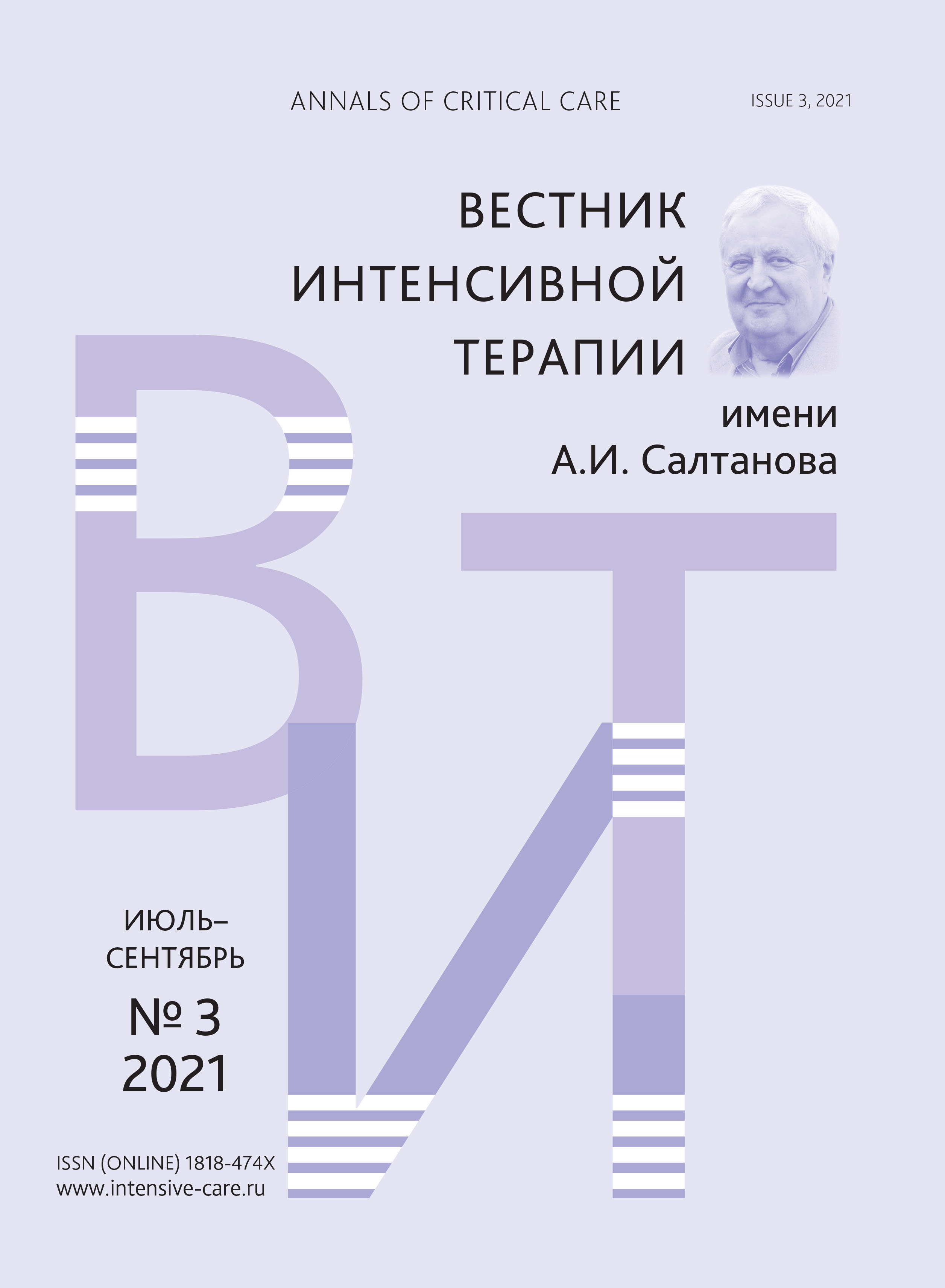Аннотация
Актуальность. В условиях пандемии, вызванной вирусом SARS-CoV-2, мировое здравоохранение столкнулось с недостаточно изученным, быстро распространяющимся заболеванием с мультисистемными изменениями, имеющим высокую долю тяжелобольных. Особенности заболевания, доказательная база, сформированная на основании опыта лечения MERS-CoV и SARS-CoV, определили необходимость анализа и обобщения опыта центров компетенции в лечении новой коронавирусной инфекции. Внедрение результатов в клиническую практику должно происходить в соответствии с принципами доказательной медицины, а также требует инициации многоцентровых клинических исследований. Цель исследования. Изучение основных характеристик и исходов лечения пациентов с тяжелым течением новой коронавирусной инфекции, получавших респираторную поддержку в отделениях интенсивной терапии инфекционного госпиталя в Коммунарке. Материалы и методы. В одноцентровом ретроспективном исследовании проведен анализ 451 случая респираторной поддержки, инвазивной (ИВЛ) и неинвазивной (НИВЛ) искусственной вентиляции легких у пациентов, находившихся в отделениях интенсивной терапии госпиталя на протяжении 5 месяцев «первой волны» пандемии. Анализировались демографические данные, коморбидность и показатели интегральной оценки тяжести состояния, респираторной механики, применение экстракорпоральных методов лечения, выживаемость. Результаты. Респираторную поддержку получили 48,8 % пациентов в отделениях реанимации и интенсивной терапии, популяция сбалансирована по демографическим признакам, индекс Чарлсона составил 4,46 ± 2,6 и был выше в группе ИВЛ. 30-дневная выживаемость пациентов, получавших респираторную поддержку, составила 33,7 %, проанализирована структура летальности. Проведен анализ показателей интегральной оценки тяжести состояния, показателей респираторной механики в зависимости от модальности респираторной поддержки, изменение их и на протяжении периода исследования. Статический респираторный комплаенс на момент начала ИВЛ составил 43 (ИР 35–51) мл/см вод. ст. ИВЛ с управляемым дыхательным объемом сопровождается более высокой летальностью в сравнении с управляемым давлением. Заключение. Пациенты отделений интенсивной терапии, получающие инвазивную или неинвазивную вентиляцию легких, имеют высокий уровень коморбидности. Показания к НИВЛ могут быть расширены у пациентов с более низкими индексом Чарлсона и оценкой по SOFA, требуется раннее выявление группы высокого риска безуспешной неинвазивной вентиляции. ИВЛ с управлением объемом связана с более высокой летальностью в сравнении с управлением давлением, в отсутствие значимых различий по шкалам интегральной оценки тяжести. Необходимы дальнейшие исследования.
Библиографические ссылки
- Gupta S., Hayek S.S., Wang W, et al. Factors Associated With Death in Critically Ill Patients With Coronavirus Disease 2019 in the US [published online ahead of print, 2020 Jul 15] [published correction appears in DOI: 10.1001/jamainternmed.2020.4568]. JAMA Intern Med. 2020; 180(11): 1–12. DOI: 10.1001/jamainternmed.2020.3596
- Berlin D.A., Gulick R.M., Martinez F.J. Severe Covid-19. N Engl J Med. 2020; 383(25): 2451–60. DOI: 10.1056/NEJMcp2009575
- Acute Respiratory Distress Syndrome Network, Brower R.G., Matthay M.A., et al. Ventilation with lower tidal volumes as compared with traditional tidal volumes for acute lung injury and the acute respiratory distress syndrome. N Engl J Med. 2000; 342(18): 1301-8. DOI: 10.1056/NEJM200005043421801
- Временные методические рекомендации «Профилактика, диагностика и лечение новой коронавирусной инфекции (COVID-19)» Версия 7 (03.06.2020). МЗРФ, 2020 г. [Vremennye metodicheskie rekomendacii «Profilaktika, diagnostika i lechenie novoj koronavirusnoj infekcii (COVID-19)» Versija 7 (03.06.2020) (In Russ)] Available from: https://static-0.rosminzdrav.ru/system/attachments/attaches/000/050/584/original/03062020_ %D0 %9CR_COVID-19_v7.pdf
- Gattinoni L., Coppola S., Cressoni M., et al. COVID-19 Does Not Lead to a «Typical» Acute Respiratory Distress Syndrome. Am J Respir Crit Care Med. 2020; 201(10): 1299–300. DOI: 10.1164/rccm.202003-0817LE
- Piraino T. Decremental PEEP titration: a step away from the table. Respir Care. 2013; 58(5): 886-8. DOI: 10.4187/respcare.02453
- Gattinoni L., Meissner K., Marini J.J. The baby lung and the COVID-19 era. Intensive Care Med. 2020; 46(7): 1438–40. DOI: 10.1007/s00134-020-06103-5
- Ye Z., Rochwerg B., Wang Y., et al. Treatment of patients with nonsevere and severe coronavirus disease 2019: an evidence-based guideline. CMAJ. 2020; 192(20): E536–E545. DOI: 10.1503/cmaj.200648
- Lazzeri M., Lanza A., Bellini R., et al. Respiratory physiotherapy in patients with COVID-19 infection in acute setting: a Position Paper of the Italian Association of Respiratory Physiotherapists (ARIR). Monaldi Arch Chest Dis. 2020 Mar 26; 90(1). DOI: 10.4081/monaldi.2020.1285
- Nolan J.P., Monsieurs K.G., Bossaert L., et al. European Resuscitation Council COVID-19 guidelines executive summary. Resuscitation. 2020; 153: 45–55. DOI: 10.1016/j.resuscitation.2020.06.001
- Coppo A., Bellani G., Winterton D., et al. Feasibility and physiological effects of prone positioning in non-intubated patients with acute respiratory failure due to COVID-19 (PRON-COVID): a prospective cohort study. Lancet Respir Med. 2020; 8(8): 765–74. DOI: 10.1016/S2213-2600(20)30268-X
- Rochwerg B., Brochard L., Elliott M.W., et al. Official ERS/ATS clinical practice guidelines: noninvasive ventilation for acute respiratory failure. Eur Respir J. 2017; 50(2): 1602426. DOI: 10.1183/13993003.02426-2016
- Carteaux G., Millán-Guilarte T., De Prost N., et al. Failure of Noninvasive Ventilation for De Novo Acute Hypoxemic Respiratory Failure: Role of Tidal Volume. Crit Care Med. 2016; 44(2): 282–90. DOI: 10.1097/CCM.0000000000001379
- Kim D.H., Park H.C., Cho A., et al. Age-adjusted Charlson comorbidity index score is the best predictor for severe clinical outcome in the hospitalized patients with COVID-19 infection. Medicine (Baltimore). 2021;100(18): e25900. DOI: 10.1097/MD.0000000000025900
- Tuty Kuswardhani R.A., Henrina J., Pranata R., et al. Charlson comorbidity index and a composite of poor outcomes in COVID-19 patients: A systematic review and meta-analysis. Diabetes Metab Syndr. 2020; 14(6): 2103–9. DOI: 10.1016/j.dsx.2020.10.022
- Gattinoni L., Chiumello D., Rossi S. COVID-19 pneumonia: ARDS or not? Crit Care. 2020; 24(1): 154. DOI: 10.1186/s13054-020-02880-z
- Gattinoni L., Coppola S., Cressoni M., et al. COVID-19 Does Not Lead to a “Typical” Acute Respiratory Distress Syndrome. Am J Respir Crit Care Med. 2020; 201(10): 1299–300. DOI: 10.1164/rccm.202003-0817LE
- Tsolaki V., Zakynthinos G.E., Makris D. The ARDSnet protocol may be detrimental in COVID-19. Crit Care. 2020; 24(1): 351. DOI: 10.1186/s13054-020-03081-4

Это произведение доступно по лицензии Creative Commons «Attribution-NonCommercial-ShareAlike» («Атрибуция — Некоммерческое использование — На тех же условиях») 4.0 Всемирная.
Copyright (c) 2021 ВЕСТНИК ИНТЕНСИВНОЙ ТЕРАПИИ имени А.И. САЛТАНОВА

